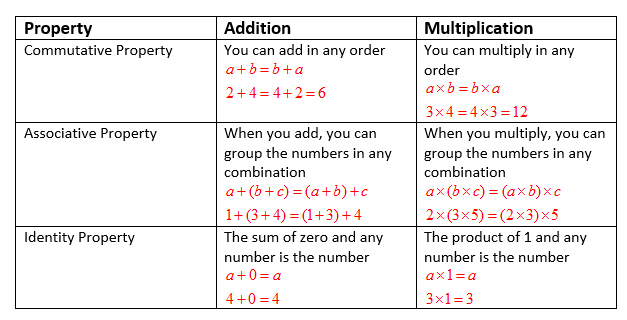Associative & Identity Property
The basic Number Properties (or laws) that apply to arithmetic operations are Commutative Property, Associative Property, Identity Property and Distributive Property. In these lessons, we will learn the associative property and identity property of numbers.
Related Pages
Identity Property Of Addition, Multiplication
More Lessons On Numbers
Math Worksheets
Summary Of Number Properties
The following table summarizes the number properties for addition and multiplication: Commutative, Associative and Identity. Scroll down the page for more examples, explanations and solutions.

Associative Property
The associative property states that the sum or product of a set of numbers is the same, no matter how the numbers are grouped.
An operation is associative if a change in grouping does not change the results. This means the parenthesis (or brackets) can be moved.
Numbers that are added can be grouped in any order.
| For example: | (4 + 5) + 6 = 5 + (4 + 6) |
| (x + y) + z = x + (y + z) |
Numbers that are multiplied can be grouped in any order.
| For example: | (4 × 5) × 6 = 5 × (4 × 6) |
| (x × y) × z = x × (y × z) |
Numbers that are subtracted are NOT associative.
| For example: | (4 – 5) – 6 ≠ 5 – (4 – 6) |
| (x – y) – z ≠ x – (y – z) |
Numbers that are divided are NOT associative.
| For example: | (4 ÷ 5) ÷ 6 ≠ 5 ÷ (4 ÷ 6) |
| (x ÷ y ) ÷ z ≠ y ÷ ( x ÷ z) |
What is the Associative Property?
The following video explains: What is the associative property? Why does it have the name it does? How can you recognize it when you see it? How can you distinguish it from other situations that look very similar?
The Associative Property
This video explains the associative property and how it can be used.
The following video shows an example on the Associative Property of Addition.
The following video shows an example of the Associative Property of Multiplication.
Identity Properties
Identity Property (or Zero Property) of Addition
When you add 0 to any a number, the sum is that number.
For example: 325 + 0 = 325.
Identity Property (or One Property) of Multiplication
When you multiply any number by 1, the product is that number.
For example: 65, 148 × 1 = 65, 148
Zero Property of Multiplication
The product of any number and 0 is 0
For example: 874 × 0 = 0
Identity Property of Addition & Multiplication
The following video shows the commutative & identity properties of addition & multiplication.
Identity Property
What is the identity property? How can you recognize it and name it when you see it? Why does is have the name it has? Why do mathematicians give EVERYTHING, even something as seemingly simple as this a name?
Multiplication: Zero Property
This video shows the zero property.
Try the free Mathway calculator and
problem solver below to practice various math topics. Try the given examples, or type in your own
problem and check your answer with the step-by-step explanations.

We welcome your feedback, comments and questions about this site or page. Please submit your feedback or enquiries via our Feedback page.